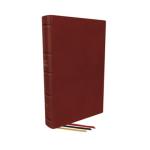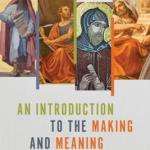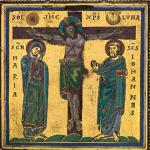It is dangerous to read the Bible. I mean the whole Bible cover to cover. It may not live up to your expectations. Of course, if we take Scripture seriously, we should read and consider the whole rather than focus on favored passages. Because I’ve committed to reading (or listening) to the whole thing, I’ve happened upon passages that challenge preconceptions and introduce new ideas. One of these is found in the lament against the king of Tyre in Ezekiel 28 (vv.11-19).
The word of the Lord came to me: “Son of man, take up a lament concerning the king of Tyre and say to him: ‘This is what the Sovereign Lord says:
“‘You were the seal of perfection,
full of wisdom and perfect in beauty.
You were in Eden,
the garden of God;
…
You were on the holy mount of God;
you walked among the fiery stones.
You were blameless in your ways
from the day you were created
till wickedness was found in you.
Through your widespread trade
you were filled with violence,
and you sinned.
So I drove you in disgrace from the mount of God,
and I expelled you, guardian cherub,
from among the fiery stones.
The king of Tyre is described by the sovereign Lord as blameless in the garden of Eden until he fell. What are we to make of this? The entire passage is quoted at the end of this post.
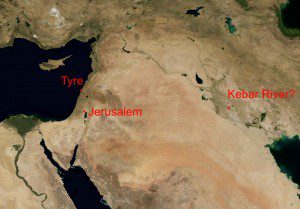 Ezekiel was a priest from Jerusalem, taken to Babylon in the first wave of exile. He wrote from the banks of the Kebar river in Babylon, 1:1). His visions are impressive. This is one of a number of prophecies against various peoples and rulers. Generally they are among the passages that seem less important. With the exception of a few lasting images (e.g. wheels within wheels and a valley of dry bones) the book of Ezekiel is not often the subject of sermons, or even of bible studies. It contains some fairly graphic sexual imagery in describing the failures of Judah, fantastic apocalyptic imagery, the repeated notion that the righteous can fall away and the wicked can turn to God with a change in final status, a massive rebuilt temple at the end of the book. There are echoes of some of these themes in the New Testament, especially in Revelation. It would seem that any interpretation of The Apocalypse of John that doesn’t take into account the Jewish context, including the book of Ezekiel, will probably miss some important points.
Ezekiel was a priest from Jerusalem, taken to Babylon in the first wave of exile. He wrote from the banks of the Kebar river in Babylon, 1:1). His visions are impressive. This is one of a number of prophecies against various peoples and rulers. Generally they are among the passages that seem less important. With the exception of a few lasting images (e.g. wheels within wheels and a valley of dry bones) the book of Ezekiel is not often the subject of sermons, or even of bible studies. It contains some fairly graphic sexual imagery in describing the failures of Judah, fantastic apocalyptic imagery, the repeated notion that the righteous can fall away and the wicked can turn to God with a change in final status, a massive rebuilt temple at the end of the book. There are echoes of some of these themes in the New Testament, especially in Revelation. It would seem that any interpretation of The Apocalypse of John that doesn’t take into account the Jewish context, including the book of Ezekiel, will probably miss some important points.
Ezekiel is admittedly a hard book to understand. Daniel Bodi in Ezekiel & Daniel (Zondervan Illustrated Bible Background Commentary) comments that “Calvin never finished his commentary on Ezekiel and Luther put forth no major effort toward its interpretation.” (p. 403, I have the hard cover edition that includes the prophets from Isaiah to Daniel and page numbers are from this version.)
The king = Satan? According to the word of the Lord in this passage the king of Tyre was in Eden, the garden of God. Clearly this is a problem for any kind of literal interpretation of the passage. Some commentators (only a few) have assumed that the passage must be referring to Satan. After all, the garden was a real place some 3500 years earlier. The only “persons” in the garden were Adam, Eve, and Satan. It isn’t reasonable to assume the passage refers to Adam, therefore it must reference the fall of Satan. Ezekiel 28 along with a passage in Isaiah 14 “How you have fallen from heaven, morning star, son of the dawn! You have been cast down to the earth, you who once laid low the nations!” are the primary references for this idea. It is highly unlikely that this is an appropriate interpretation of either passage, and it is a particularly strained interpretation of Ezekiel 28.
Most commentators I’ve found (and I haven’t been able to consult too many) agree that the passage refers to the king of Tyre and is a prophecy against Tyre and its king for their violence and greed. Daniel Block (NICOT: Ezekiel Chapters 25-48) comments on both the judgement speech against the king of Tyre in verses 1-10 and the lament in 11-19. These cannot be separated and both refer to the actual king and kingdom of Tyre (see also ch. 26-27). The king of Tyre was guilty of hubris evidenced, among other things, in dishonest trade. Application of this passage to the fall of Satan can only be made if it is ripped out of context and taken in isolation. Block quotes part of John Calvin’s commentary on Isaiah 14 and applies it to this passage as well: “But when passages of Scripture are taken up at random, and when no attention is paid to the context, we need not wonder that mistakes of this kind frequently arise. … But as these inventions have no probability whatever, let us pass them by as useless.” (p. 119)
The image of a garden and the cherub and similar winged human-animals are common in the ancient Near East with a number of parallels. Bodi notes:
Such parallels imply that in the description of a paradise-like garden, Ezekiel is drawing on stereotypical formulas, stock phrases, and traditional themes. The advantage of such a procedure is that it facilitates communication. His audience will quickly grasp the allusions made in Ezekiel’s message. (p. 467)
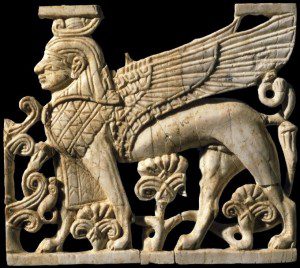 He also comments:
He also comments:
The growing collection of Phoenician ivories attests to the prominence of the cherub motif in Phoenician art and iconography. Especially noteworthy is the carving of a king-cherub, whose face appears to be a portrait of the king and under whose feet are seen alternating patterns of stylized tulip flower gardens and mountains. (p. 467)
There are better images of the cherub motif (human head, winged bull or lion body) I have found in books, but the one above is the best available image for use (credit British Museum), Phoenician origin, found in Nimrud with Egyptian influences, ca. 900 BC to 700 BC. Cherub motifs are not uncommon in the ancient Near East.
Ezekiel apparently has the Israelite story of the garden of the Lord in mind. There are multiple allusions back to Genesis 3. “In placing the king of Tyre in Eden Ezekiel is adapting a well-known biblical tradition of the garden of God as a utopian realm of prosperity and joy.” (Block p. 106) The king was (like adam) created by God, divinely authorized to rule, was not satisfied with his role and “fell,” he was punished by humiliation and death (paraphrasing Block pp. 117-118).
Joseph Blenkinsopp in Interpretation: Ezekiel comments on the garden of Eden (and points out that it is possible that both Genesis 3 and Ezekiel 28 point to some other then well known, but now lost to us, story):
It would be natural to assume that this lament draws on the familiar story of the Garden of Eden in Genesis, but it is equally possible to read both as distinct forms of an ancient mythic narrative well known in the ancient Near East. Whereas here it serves to convey a political message, the Genesis version is given universal significance precisely by being placed at the beginning of the biblical story. In this, as in other instances, the first question to ask is not, Did it really happen? but, What does it mean? It invites attention to its symbolic meaning as a diagnosis of the human situation from a perspective that is both theologically and psychologically profound. Leaving aside the fate of Tyre, a matter of past history, what both versions convey is that sin emerges out of our interaction with the environment and in society … Both speak, in different ways, of the corruption of wisdom (see Ezek. 28:17), let us say of the human capacity for knowledge, mastery, and the quest for fullness of life. Both take seriously the consequences of deviating from the original purpose of creation while affirming the possibility of restoration. (pp. 124-125)
Ezekiel uses the imagery of the garden of God and Eden in chapter 31 as well, comparing Assyria and Egypt with mighty and beautiful trees, the cedars of Lebanon and trees in the garden. This use of Eden raises fewer questions because it is clearly meant as an analogy. However, it provides additional evidence for the importance of this imagery in Ezekiel’s community.
So What? Whether Ezekiel has Genesis 3 in mind, or both Genesis 3 and Ezekiel build on another story, this passage tells us something about the way the ancient Israelites viewed their stories of origin recorded for us in the first 11 chapters of Genesis, in particular in this case Genesis 3. There was not a wooden literalism here. Although it can offend our expectations, it didn’t contradict their understanding of the stories, or the imagery contained in the stories, to place the King of Tyre as a guardian cherub in the garden of Eden. Wow!
Note as well, that this passage in Ezekiel isn’t a story with a message. Nor is it a historical account told from the perspective of the Israelites as we find in the books of Samuel, Kings, and Chronicles (where other written sources were also used and acknowledged). This is the word of the Lord given to Ezekiel. If we take the inspiration of Scripture seriously this can’t be brushed away easily. Many claim Scripture as the word of God and then assert that “God does not lie” to drive home particular preferred interpretations. I have often been confronted with just such an argument when discussing the proper interpretation of the early chapters of Genesis. Of course, it is also said that we should let Scripture interpret Scripture. Genesis 3 and Ezekiel 28 should help us understand what this means and help guide our understanding of the forms and genres that can be used to convey the word of God.
In so far as we are able, we need to read the stories with ancient, not modern, eyes.
What do you make of the king of Tyre in Eden, the garden of God?
How should we interpret such passages?
If you wish to contact me directly you may do so at rjs4mail[at]att.net.
If interested you can subscribe to a full text feed of my posts at Musings on Science and Theology.
(This is a repost – but worth our consideration.)
Ezekiel 28:11-19
The word of the Lord came to me: “Son of man, take up a lament concerning the king of Tyre and say to him: ‘This is what the Sovereign Lord says:
“‘You were the seal of perfection,
full of wisdom and perfect in beauty.
You were in Eden,
the garden of God;
every precious stone adorned you:
carnelian, chrysolite and emerald,
topaz, onyx and jasper,
lapis lazuli, turquoise and beryl.
Your settings and mountings were made of gold;
on the day you were created they were prepared.
You were anointed as a guardian cherub,
for so I ordained you.
You were on the holy mount of God;
you walked among the fiery stones.
You were blameless in your ways
from the day you were created
till wickedness was found in you.
Through your widespread trade
you were filled with violence,
and you sinned.
So I drove you in disgrace from the mount of God,
and I expelled you, guardian cherub,
from among the fiery stones.
Your heart became proud
on account of your beauty,
and you corrupted your wisdom
because of your splendor.
So I threw you to the earth;
I made a spectacle of you before kings.
By your many sins and dishonest trade
you have desecrated your sanctuaries.
So I made a fire come out from you,
and it consumed you,
and I reduced you to ashes on the ground
in the sight of all who were watching.
All the nations who knew you
are appalled at you;
you have come to a horrible end
and will be no more.’”












